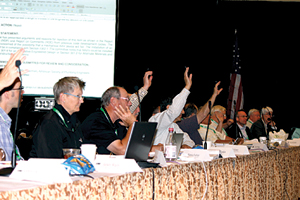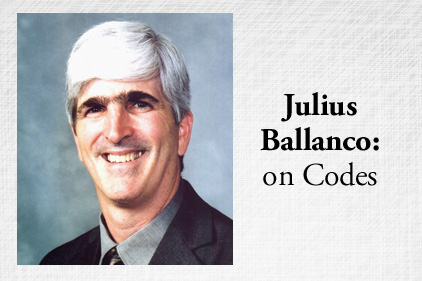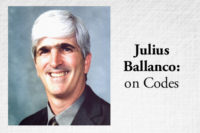
|
| Photo credit: ©istockphoto.com/vm |
One of the difficulties I have attending the IAPMO Plumbing Technical Committee meetings is that, besides taking notes to write my monthly column, I also serve as a voting member of the TC representing ASPE.
In addition, I submit code changes on behalf of clients. Hence, if I am critical of the decisions by the TC, I am actually criticizing myself. A committee member must stand by the action taken by its committee.
The one area of the Uniform Plumbing Code that is the most different from the other plumbing codes in the United States and Canada is the drainage and venting chapters. ASPE submitted a number of changes to these chapters to bring the UPC in line with the published sizing and design requirements of plumbing engineers.
If you said the word “engineer” or “engineering” 20 years ago at an IAPMO meeting, you would have thought it was a four-letter word. Today, there is a mutual respect shown to engineers and engineering. That doesn’t mean there isn’t the occasional dig at the engineering community, but engineers have been known to throw jabs at contractors and inspectors.
Because of ASPE’s backing, the code changes on drainage sizing were discussed in great detail. That is not to say these changes received favorable consideration. Perhaps the greatest concern was switching from a sizing method that UPC users have been familiar with for the last 75 years to a sizing method more in line with the later Hunter research. Although, all the TC members were open to such changes.
The discussion on reducing the pipe size always is the most heated. Two sizes proposed for reduction were shower drains and kitchen drains. The UPC requires a 2-in. shower drain. For a kitchen sink, it allows a 1 1/2-in. trap, but requires a 2-in. trap arm. Both fixtures were proposed to have the drain pipe size lowered to 1 1/2 in.
ASPE did a good job presenting the technical issue. However, there was talk on the amount of drain cleaning already required. So often, increased numbers of stoppages translates to mean too small a drain size. Normally, the opposite is true and the drain is oversized. This concept is very difficult to grasp, especially when many had it ingrained during their apprenticeship training.
After the discussion concluded, the lowering of the shower drain to 1 1/2 in. was accepted. The lowering of the kitchen drain size was not.
Two approaches were taken to the overall sizing requirements. The first was to add the sizing table from the appendix to the body of the code. The other was to tinker with the sizing requirements to the current table. If the sizing table from the appendix was accepted, there would still be an allowance to use the old sizing table.
In the end, the table from the appendix was not criticized as being inaccurate. It was more of a concern that there should only be one sizing method identified in the code. The recommendation was that an ad-hoc committee be created to redo the drainage sizing requirements for the UPC. While not a win for ASPE, in many ways it was a win. It is common in the code profession to have a subcommittee work through significant changes before they are accepted in the body of the code.
Setting the table
The tinkering of the current tables appeared to have very favorable considerations. Only minor changes were accepted in the end. The remaining changes were rejected with the recommendation that they be considered by the ad-hoc committee.
In the venting chapter, there were pluses and minuses in the final outcome. Circuit venting was removed from the appendix on engineered design and placed in Chapter 9 as a standard venting method. This had the strong support of the UA representatives on the TC.
During one of the breaks, a colleague on the TC said to me, “You were shocked by the outcome of the circuit venting code change.” I had to admit I was. Having seen it turned down in the past, I didn’t think it would receive favorable consideration.
The wet venting section was changed in what was identified as a cleaning up of the section. The problem with the cleaning up is that back-to-back horizontal wet venting was removed from the UPC. ASPE had a change to keep the back-to-back allowance in the code, but that change was not accepted. The only way to design a back-to-back is as an engineered design. Many engineers, myself included, like to use back-to-back wet venting on engineered residential buildings, hotels and motels.
Not surprisingly, air-admittance valves were not accepted under the venting requirements. Even though AAVs are used in every state, there still is a hardline approach against the technology. Everyone is waiting for the massive failures to occur, with the more than seven million valves installed in the U.S. throughout the last 25 years. The question is starting to become, “How long do you wait to prove or disprove your prediction of imminent failure?”
One area of the code that the UPC was consistent in with every other code was storm-drainage sizing. However, following the ASPE Research Foundation report, all the plumbing codes are considering changes to the method of sizing a storm-drainage system. The IPC already accepted the new sizing method.
The TC acknowledged the ASPE study, but didn’t see the need to change the sizing at this time. As a result, for the first time in many years, storm-drainage sizing will be different between the codes. However, if the plumbing engineer follows the ASPE sizing method which also appears in the UPC, he or she will comply with the UPC storm-drainage section. The piping will actually be larger than the UPC requires.
It is interesting that the UPC is often accused of requiring larger pipe sizes than other plumbing codes. Yet, for the storm-drainage system, the UPC will require smaller pipe sizes than the other codes.
The other sizing method that was completely changed was medical gas sizing. The new sizing methods from the ASPE Plumbing Engineering Design Handbook were added to the code.
The TC just completed its written ballot on the proposed code changes. The results will be published very soon. You can download the results at www.iapmo.org.
The next review of these changes will be at the IAPMO Annual Conference in Minneapolis this September. Every IAPMO member will be eligible to vote at this meeting.



